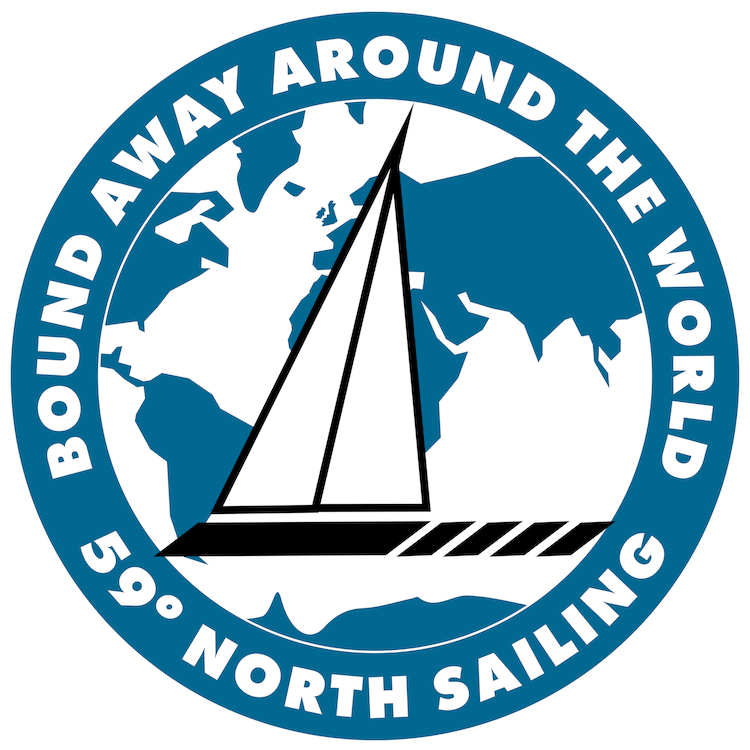I feel like I'm decidedly in the minority when it comes to the modern ocean sailing game. My boat is from 1966, my GPS a handheld unit from 1993, we've got paper charts onboard and no electrics whatsoever besides the LED lighting. Hank-on headsails (we carry five of them), tiller steering and a 35-gallon water tank. The engine only works to charge the batteries and get us in and out of the dock. But I feel safe aboard Arcturus.
1). Despite the lack of modern cruising gear, we've got all the safety gear. A Winslow liferaft (best on the market according to Steven Callahan, and he would know), lifejackets and harnesses for the crew, AIS, two EPIRBs, 30 gallons of water in gallon jugs in the bilge, a sat phone and all the requisite flares, radar reflectors, etc etc.
And 2). I know what I'm doing, and I've simplified the boat.
This is seamanship - note the storm boards over the big saloon windows.
I have a problem with a lot of sailors that head out to sea with the idea that technology is going to make them safe. Mia and I often joke around that a lot of the current sailing industry makes and markets stuff with the idea that it will make life on the boat easier. Electric winches and windlasses, stack-packs for mainsails, mainsail furling systems, headsail furling systems, water makers, generators, etc etc etc. I could go on and on and on. But that's just not the truth. These systems make life at sea convenient.
And ultimately, they make life harder, not easier. Even if everything works flawlessly, you've still got to make electricity for all that stuff, and that requires running an engine or creating even more complexity by adding solar or wind charging, which is just one more link in the chain.
Ready to step the new rig in Annapolis.
On Arcturus, yes we had to go forward to change headsails, and yes we had to pump water by hand out of the tank, and yes we had to plot our positions on paper, and yes we had to fiddle with the wind vane when the breeze got shifty, and yes we have to furl the mainsail when we put it away, and yes we have to haul in the anchor by hand, and yes we have to row ashore in the dinghy, etc etc. But you know what we don't have to do? We don't have to charge batteries more than 1 hour every 4th day, we don't have to mess with fidgety water pumps, we don't have to live with the uncomfortable glow of a chart plotter in the cockpit, we don't have to live with partway furled headsails not setting right, we don't have to worry that the autopilot is going to take a dump. That's my definition of comfort at sea, and all of those supposed 'inconveniences' make it more of an adventure for us.
First, you must realize that none of that crap is necessary, and that all of it represents very recent developments in the history of sailing. Then, you must understand the limitations of all that fancy gear. If you can live with them (and financially afford them), then by all means go right ahead. But know what to do when they fail.
This is seamanship - fabricating Arcturus' new centerboard lifting mechanism with sculptor Rodney Carroll in his Baltimore studio.
I heard recently a suggestion on signaling devices, being better "seen" at sea. Traditionally, you'd carry an assortment of flares, battery powered lights and radios and whatnot. Stuff that will work no matter how badly damaged the boat itself is. These were 'primitive', I heard. A simple AIS installation would solve the matter entirely, making all of that stuff redundant, I heard. And what would happen if the boat lost power? I wondered. Solar panels and a backup source of electricity! If you lose all power, I heard, you're in big trouble, and no amount of flares are going to help you.
This annoys me to no end. It's missing the point entirely! You cannot rely on technology to save the day. That's just not what ocean sailing is about. Everyone that decides to head offshore is taking a risk, perhaps bigger than they account for. It's wilderness out there, no matter how 'connected' you might feel with SPOT devices, sat phones, SSB and the like. You're on your own in a hostile world, and you'd better know how to take care of yourself.
Think about this the other way around. Pare it down. There are two or three major systems on a sailing boat - the hull, the rig and (sometimes) the engine. Keeping the water out of the hull is a given. Beyond that, keep the rig up, or the engine running (one of the two will suffice), and the boat will make it wherever it's going. A battery-powered (or oil-lit) set of nav. lights would make you better seen by others (and keep you legal), and a few gallons of water for the crew will keep you healthy. That's it folks. Anything beyond that only increases safety, convenience and comfort. You've got the essentials covered. This is how I believe any offshore passage should be approached. Start with the basics and build on that.
This is seamanship - studying the paper charts before departing
St. Pierre last summer, en route to Ireland.
As a final note, I wonder what people think the definition of seamanship is? You hear stories of heroic rescues, of patched-together rudders and masts when something goes wrong at sea, and these are the thoughts that come to mind. But for myself, seamanship starts long before the voyage. Getting the boat ready, getting yourself ready, thinking of all the contingencies before they happen. The best seamanship then, is exhibited by the crew with the least amount of stories. The best seamanship is boring.







